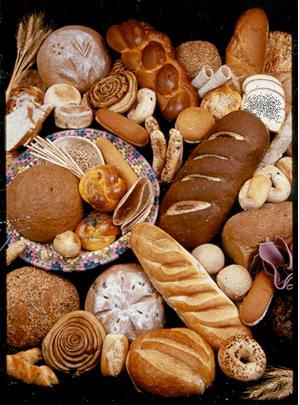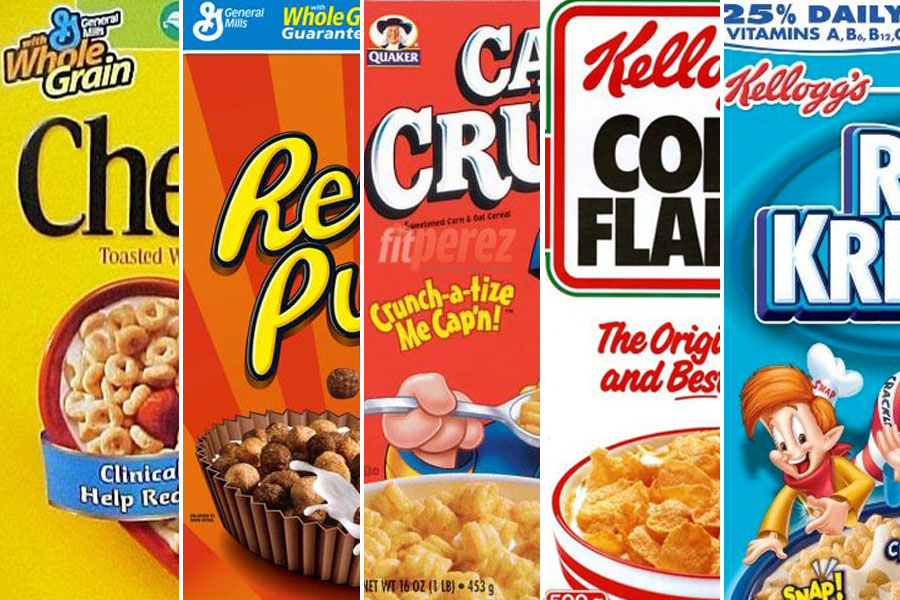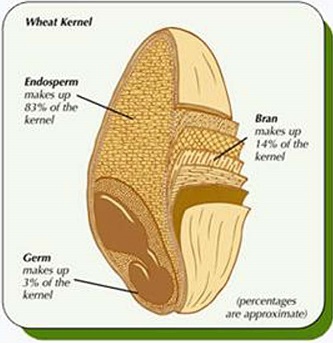True grains are the seeds of grasses:
• Wheat. Various species include Durum, Semolina/CousCous (purified from Durum), Spelt, Bulgar, Triticale (a wheat hybrid), Kamut, Einkorn and Emmer (two of the earliest cultivated forms)
Wheat - "Ain't what it used
to be"
•Rye
•Barley
•Oats
•Rice
•Millet
•Corn (Maize)
•Sorgum
•Teff - superlative calcium content (1 cooked cup has 123mg)
•Wild Rice - aquatic seed mostly in freshwater lakes of Canada and the Great Lakes area; nutty flavor
•Others
Pseudo grains are the seeds of broadleaf plants, including:
•Amaranth - high amino acid content, contains lysine; combines well with other grains'
•Quinoa - complete protein (with the 8 essential amino acids); fluffy, slightly crunchy, slight nutty flavor
•Buckwheat
•Chia
 Nutritionless,
REFINED grains are a staple of the Western Diet
Nutritionless,
REFINED grains are a staple of the Western DietEven UNrefined grains contain negligible amounts of vitamins A, C, D or B12. Maize/corn is the only grain that contains beta-carotene (vitamin A's metabolic precursor);
Refined (Processed) and high temperature-milled grains are undesireable. These include: devitalized foods such as pastries, cake, cookies, crackers, white bread, pasta, cereal, noodles,pretzels, tacos, waffles, pancakes, muffins; grains extruded/pressed to make crunchy breakfast cereals;
Grains - How to prepare the healthy way

- Refined grains lack minerals (since the parts containing the fiber and ~80% of the nutrients have been removed) - E.g. white flour, made from the endosperm of the grain is mainly starch; diets high in such refined grains lead to serious mineral deficiencies. E.g. bone loss, Parkinson's, arrrythmia.
Most all consumed grains turn rapidly into glucose, causing blood sugar spikes. Fiber in whole grains slows down the conversion, but the end product is still sugar;
Quinoa - is on the low end of the glycemic index (GI) and won't cause blood sugar spikes; good choice for diabetics;
Barley - cooked pearl barley has the lowest GI of all the grains (~25). Pearl barley is a great substitute for white rice;
A "NO-GRAIN" diet is the way to go if you want to lose weight. Use coconut or almond flour as grain substitutes
Regular grain consumption leads to INSULIN resistance and "FAT STORAGE". Ongoing daily blood glucose spikes increases pancreatic INSULIN production for the purpose of taking the glucose out of the blood and into cells. After repeated bombardment from INSULIN, the cells protect themselves from INSULIN by down-regulating their INSULIN receptors. The result is that INSULIN's message can no longer be "heard"effectively, and blood sugar increases or is stored as fat, with all the consequential health problems of metabolic syndrome, including type 2 diabetes, CVD, and obesity.
- Typical symptoms can include:
• Fatigue, sleepiness, depression, brain fog
• Hypoglycemia - i.e low blood sugar
• Increased trigycerides, blood pressure
• Weight gain -due to increased fat storage
"--- antinutrients in whole grains include enzyme inhibitors which can inhibit digestion and put stress on the pancreas; irritating tannins; complex sugars which the body cannot break down; and gluten and related hard-to-digest proteins which may cause allergies, digestive disorders and even mental illness."
"Proper preparation of grains is a kind and gentle process that imitates the process that occurs in nature. It involves soaking for a period in warm, acidulated water in the preparation of porridge, or long, slow sour dough fermentation in the making of bread. Such processes neutralize phytic acid and enzyme inhibitors."
- Sally Fallon, Weston A. Price Foundation
See details here: Wheat - "Ain't what it used to be"
Some people are intolerant to certain amino acid sequences in wheat, barley, rye and possibly oats. Prolamins are proteins containing amino acid sequences (E.g. Pro-Ser-Gln-Gln and Gln-Gln-Gln-Pro ) which can provoke an inflammatory reaction that is damaging to intestinal tissue that is sometimes diagnosed as Celiac Disease in those with severe intolerance. E.g. In those overly sensitive to gliadin in gluten, the immune system creates antibodies to attack gliadin. The real problem occurs as water-soluble gluten dissolves, since it can then bind to body cells, and during the immune system's "fight"with the gliadin, those cells and surrounding tissue also get "hurt".
- Prolamins include:
• Gliadin (a component of gluten) - mainly in wheat, rye and barley;
• Hordein - in barley
• Secalin - in rye
• Avenin - in oats (doesn't contain as many inflammation-provoking amino acid sequences as gliadin, hordein and secalin)
- The grains with the highest amount of inflammation-provoking amino acid sequences in prolamins. Include Wheat, Barley, Oats, Rye, Semolina, Bulgar, Durum, Kamut, Spelt, Triticale.
- Some grains, even though they contain gluten, do not have significant amounts of prolamins (such as gliadin). These are usually tolerated by those with Celiac Disease. These include Rice, Corn, Buckwheat , Millet,Sorghum, Teff, Quinoa, Amaranth and possibly Einkorn wheat.
- Gluten-containing grains are hard for us to digest and absorb. These should be appropriately prepared for consumption. Sprouting and overnight-soaking do not have much effect on gluten levels - only sourdough bread made traditionally using 3-day fermentation (souring) will be gluten-free. Be aware that many sourdough breads sold are not gluten-free because they are not traditional sourdough breads - the real thing will list a sourdough starter instead of yeast in their ingredient list.
"--- Phytic acid, for example, is an organic acid in which phosphorus is bound. It is mostly found in the bran or outer hull of seeds. Untreated phytic acid can combine with calcium, magnesium, copper, iron and especially zinc in the intestinal tract and block their absorption."
- Sally Fallon Weston A. Price Foundation